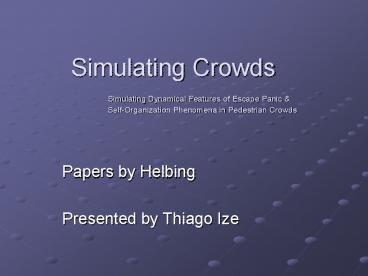Simulating Crowds Simulating Dynamical Features of Escape Panic - PowerPoint PPT Presentation
1 / 13
Title:
Simulating Crowds Simulating Dynamical Features of Escape Panic
Description:
Self-Organization Phenomena in Pedestrian Crowds. Papers by Helbing. Presented by Thiago Ize ... Excels at crowds, not individual pedestrian movement ... – PowerPoint PPT presentation
Number of Views:93
Avg rating:3.0/5.0
Title: Simulating Crowds Simulating Dynamical Features of Escape Panic
1
Simulating Crowds Simulating Dynamical Features
of Escape Panic Self-Organization Phenomena
in Pedestrian Crowds
- Papers by Helbing
- Presented by Thiago Ize
2
Why do we care?
- Easy to use when doing crowds
- For the layman animator
- For the sleep deprived programmer
- Lots of goodies come for free ?
- Escape panic features
- Faster-is-slower effect
- Crowding around doorway
- Mass behavior
- Normal pedestrian traffic features
- Lanes
- Waiting at doors
- Braking rules
3
The model
Missing the !
pushes a away from all pedestrians, ß
closest part of static things, ?, that a should
avoid
gets a to desired velocity,
pushes a towards certain pedestrians, i
These use potential force fields
4
What are potential force fields?
- Field around an object that exerts a force on
other objects - Used by roboticists
exponential
square
directional
5
The model normal condition
- Lots of room for choice of potential function
- Helbing uses an elliptical directional potential
directional
Directional potential
Gradient
a
ß
a
a
Force applied on a by ß
6
What does that do?
- Lane formation
- Potential force behind leader is low
- Leader is moving away (force is not increasing)
- Turn taking at doorways (its a polite model)
- Easy to follow someone through the door.
- Eventually pressure from other side builds up and
direction changes - Rudimentary collision avoidance
7
Panic !!
- People are now really close together
- Body force counteracts bodily compression
- Sliding friction force people slow down when
really close to other people and things - Desired speed, , has increased
- Switch from directional to exponential potential
field (but would probably still work with
directional)
8
The model - panic condition
Exponential potential field
body force
sliding friction force
g() 0 if a and ß are not touching, otherwise
distance from a to ß
tangential velocity difference
normal from ß to a
9
What does that do?
- Faster-is-slower effect
- Sliding friction term
- High desired velocity (panic)
- Squishes people together
- Gaps quickly fill up
- Exits get an arch-like blockage
10
Integrating panic with normality
- Sliding friction and body term can safely be used
in all situations - Would probably make all scenes look better
- Panic occurs when everyones desired velocity is
high and points to same location
11
Mass behavior
- Confused people will follow everyone else
average direction of neighbors j in a certain
radius Ri
individual direction
panic probability
12
Problems
- Possible to go through boundaries
- Can be fixed by increasing force of boundary
- Sometimes good
- Excels at crowds, not individual pedestrian
movement - When focus is on big crowds and not on
individuals, this is good.
13
Questions?































